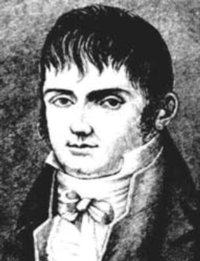C. S. Rafinesque
|
|
Constantine Samuel Rafinesque-Schmaltz (October 22 1783-September 18 1840) was a nineteenth-century polymath. Many would call him a genius, but also an eccentric, sometimes close to insanity. He was very successful in various fields of knowledge; zoologist, botanist, malacologist, meteorologist, writer, evolutionist, polyglot, translator, and he wrote on such diverse topics as anthropology, biology, geology, and linguistics; but was honored in none during his lifetime. Today, it is generally recognized that this genius was far ahead of his time.
Rafinesque was born in Galata, a suburb of Constantinople. He spent his youth in Marseilles, France and was mostly self-educated. By the age of twelve, he knew Latin and had built a herbarium.
At the age of nineteen, he went to America but in 1805 left again to Palermo, Sicily, where he became a successful businessman, mostly in the trade of medicinal plants. He was also secretary to the American consul. During his stay, he collected flowers and took an interest in fishes, naming a few. In 1815, after his common-law wife left him and his son (named after Carolus Linnaeus) had died, he returned to America. He lost all his books (50 boxes) and all his specimens, with more than 60,000 shells, when the ship foundered near the coast of Connecticut.
In New York he became a member of the newly established ‘Lyceum of Natural History’ By 1818, he had collected and named more than 250 new species of plants and animals. Slowly he was rebuilding his collection of objects from nature.
In 1819 he became professor of botany at Transylvania University, Lexington (Kentucky), teaching French and Italian as well. He started at once describing all the new species of plants and animals he encountered. In 1825 his book Neogenyton, drew much criticism from fellow botanists, causing his writing further to be ignored. In the spring of 1826 he was dismissed from the university, for either having an apparent affair with the university president's wife or for attending even less classes than his students.
He left for Philadelphia without employment. He gave public lectures and started publishing again, mostly at his own expense. His book Medical Flora, a manual of the Medical Botany of the United States of North America (1828-1830) became his most important work. In Herbarium rafinesquianum, he described numerous new plants. He also became interested in the collections of Lewis and Clark. Among them, he gave a scientific name to the Black-tailed Prairie Dog (Cynomys ludovicianus), the White-footed Mouse (Peromyscus leucopus) and the Mule Deer (Odocoileus hemionus). In the books he published between 1836 and 1838 he proposed hundreds of new genera and thousand of new species.
Rafinesque.AtlanticJournal.1832-1833..jpg
He even discovered an unnamed bat in J.J. Audubon's house no less. He developed a theory of evolution much earlier than Darwin. In 1836 he also created a 19th century hoax, when claiming, in a document Walam Olum, to be able to translate the writings of the early Delaware Indians.
He died unnoticed of cancer in Philadelphia. He was buried there at Ronaldson's cemetery. His considerable collections were sold as junk or destroyed. In 1924 his remains (or what was thought to have been his remains) were brought back to Transylvania University to rest in a place of honor, in a tomb marked by the epitaph 'A life of travels'. But most likely, Rafinesque lies in an unmarked grave in Philadelphia.
In 1841 Thomas Nuttall proposed, in his honor, the genus name Rafinesquia, (family Asteraceae), with two species. Rafinesque himself had proposed this name twice, but was each time turned down.
- Rafinesquia californica (California Plumeseed)
- Rafinesquia neomexicana (Desert Chicory, Plumeseed)
The standard botanical author abbreviation Raf. is applied to species he described.
Selected works
- Specchio delle scienze, Palermo 1814
- Analyse de la nature, Palermo 1815 (outlining a new system of classification)
- Florula ludoviciana, 1817
- Neogenyton, 1825
- Medical Flora, a manual of the Medical Botany of the United States of North America (1828-1830)
- Atlantic Journal and Friend of Knowledge (eight parts) (1832-1833)
- A life of Travels, 1836
- New flora and botany of North America (four parts) (1836-1838)
- Alsographia americana, 1838
- Sylva tellurana, 1838
Reference
Boewe, C. 1982. Rafinesque: A sketch of his life with bibliography by T. J. Fitzpatrick, revised by Charles Boewe. M & S Press, Weston, Massachusetts.
External links
- Fishes sketched by Rafinesque (http://faculty.evansville.edu/ck6/bstud/rafsketch.html)
- Fishes first described by Rafinesque (http://faculty.evansville.edu/ck6/bstud/raffish.html)
- Rafinesque’s Big-eared Bat (http://www.nsrl.ttu.edu/tmot1/plecrafi.htm)
- IPNI on Rafinesque (Raf.) (http://www.ipni.org/ipni/authorsearch?id=8096-1&query_type=by_id&back_page=query_author.html&output_format=object_view)
- Smithsonian Magazine article (http://www.smithsonianmag.si.edu/smithsonian/issues99/jan99/rafin.html)de:Constantine S. Rafinesque-Schmaltz

